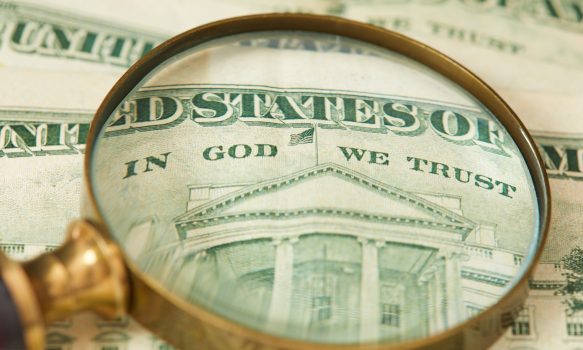
Christian Nationalists sometimes justify violations of separation of church and state by pointing to things like “In God We Trust” being our national motto and “under God” appearing in the Pledge of Allegiance. These practices, they argue, prove that religion and government have long mixed in the United States.
The argument doesn’t hold water. These “civil religion” practices don’t go to founding period; most are of much more recent vintage. A look at the history of each one is enlightening.
The United States didn’t have an official motto for most of its history. The secular (and unifying) phrase “E Pluribus Unum” (Latin for “Out of Many, One”) filled that role unofficially until July 30, 1956, when President Dwight D. Eisenhower signed legislation declaring “In God We Trust” the country’s motto. The phrase would have been alien to our founders.
The use of “In God We Trust” on U.S. money has a longer lineage, and it first appeared on coins in the North during the Civil War. In 1861, a Christian minister from Pennsylvania, the Rev. Mark. R. Watkinson, wrote to Salmon P. Chase, secretary of the treasury, and suggested that a new coin be created that included the phrase “God, liberty, law.” Production of this coin, Watkinson argued, would “relieve us from the ignominy of heathenism” and “place us openly under the divine protection we have personally claimed.” (Watkinson apparently believed that the Civil War was due to the nation “disowning God.”)
Chase liked the idea but rejected Watkinson’s suggestion for a motto. “God, Our Trust” was considered and later tweaked to “In God We Trust.” The motto first appeared on a two-cent piece minted in 1864. But it was not used uniformly on coinage going forward. President Theodore Roosevelt believed references to God on money were inappropriate and had it removed from gold coins minted in 1907.
He later reversed the decision after public outcry, and it has appeared on all coins since 1938. Congress did not mandate the use of the motto on all paper currency until 1955, and it’s still possible to find old notes that don’t have it. (Interestingly, the first coin officially minted by the U.S. government, the Fugio cent of 1787, contained no religious phrases. Instead, it used two mottos – “We Are One,” a reference to the 13 original colonies, and the somewhat cryptic “Mind Your Business.”)
This familiar patriotic statement was written in 1892 by the Rev. Francis Bellamy to mark the 400th anniversary of the voyage of Christopher Columbus, and at that time, it didn’t contain the words “under God.” That was phrase was added in 1954, long after Bellamy’s death.
Bellamy, who held Socialist views, had been removed from his pulpit for being too radical and landed at a popular magazine called The Youth’s Companion. The magazine sold American flags as a side hustle, and Bellamy, in a ploy to boost sales, came up with a flag-salute ritual and penned the Pledge.
Bellamy’s original Pledge, which read, “I pledge allegiance to my flag and the Republic for which it stands one nation, indivisible, with liberty and justice for all,” has been altered twice. In 1923 the American Legion and the Daughters of the American Revolution successfully petitioned to have “my flag” changed to “the flag of the United States of America.” In 1954, “under God” was added after a lobbying campaign led primarily by the Knights of Columbus.
If you’ve read this far, you might have noticed something: The 1950s keep popping up. That’s when “In God We Trust” was made the national motto, the phrase was mandated for use on all currency and the Pledge was altered.
So, what was going on then? The United States was locked in a struggle against “godless Communism” in the former Soviet Union. Many political and religious leaders wanted to differentiate the United States from that totalitarian state and decided that civil religion – sometimes called “ceremonial deism” – should be part of the answer. The vast majority of Americans back then were Christians, but these leaders decided that generic religiosity – endorsements of God instead of Jesus Christ – was the way to go. (For more on this, see AU Trustee Brian Kaylor’s book Baptizing America: How Mainline Protestants Helped Build Christian Nationalism.)
There you have it. These “traditional” uses of religion by the state are really just relics of the Cold War. As such, they hardly excuse the constant violations of church-state championed by Christian Nationalists.